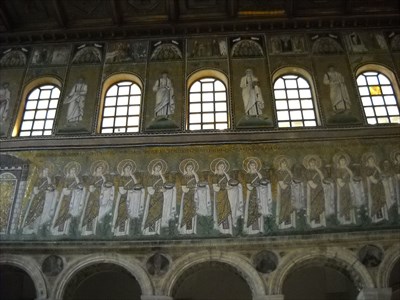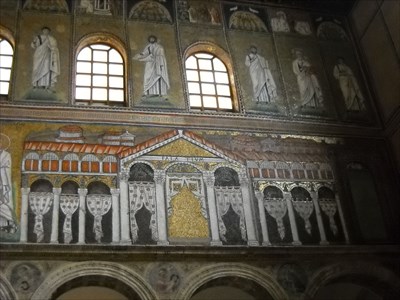
 Ravenna was the seat of the Roman Empire in the 5th century and then of Byzantine Italy until the 8th century. It has a unique collection of early Christian mosaics and monuments.
Ravenna was the seat of the Roman Empire in the 5th century and then of Byzantine Italy until the 8th century. It has a unique collection of early Christian mosaics and monuments.
All eight buildings – the Mausoleum of Galla Placidia, the Neonian Baptistery, the Basilica of Sant'Apollinare Nuovo, the Arian Baptistery, the Archiepiscopal Chapel, the Mausoleum of Theodoric, the Church of San Vitale and the Basilica of Sant'Apollinare in Classe – were constructed in the 5th and 6th centuries. They show great artistic skill, including a wonderful blend of Graeco-Roman tradition, Christian iconography and oriental and Western styles.
The Basilica of Sant'Apollinare Nuovo, built by Theoderic (493-526) next to his palace, was originally used as a Palatine Church of Arian religion.
After the Byzantine reconquest and consecration to the orthodox faith (mid-6th century), the Basilica was dedicated to St. Martin, bishop of Tours. Tradition has it that in 9th century the relics of St. Apollinaris were removed from the Basilica of Sant’Apollinare in Classe and transported here.
On that occasion, the church was dedicated to Saint Apollinaris and called “Nuovo” (new) in order to differentiate it from the church of the same name in Classe.
The gabled façade of the Basilica is marked by two side pilasters and provided with a mullioned window, topped by two small openings.
Originally, it was probably delimited by a four-sided porch; today it is decorated with a simple but well-balanced 16th-century marble porch. On the right side of the façade rises a cylindrical bell-tower dating back to the 9th or 10th century.
Inside the building, you can admire the magnificent mosaic decoration of the original church documenting the stylistic, iconographical and ideological evolution of Byzantine wall mosaics from the era of Theoderic to that of Justinian.
The 26 christological scenes from the period of Theoderic are one of the biggest monumental cycles and, at the same time, the most ancient original mosaic work on the New Testament of all times.
Sources : The Church


 Capitale de l'Empire romain au Ve siècle, puis de l'Italie byzantine jusqu'au VIIIe siècle, Ravenne possède un ensemble de mosaïques et de monuments paléochrétiens unique au monde.
Capitale de l'Empire romain au Ve siècle, puis de l'Italie byzantine jusqu'au VIIIe siècle, Ravenne possède un ensemble de mosaïques et de monuments paléochrétiens unique au monde.
Ces huit bâtiments – mausolée de Galla Placidia, baptistère néonien, basilique Sant' Apollinare Nuovo, baptistère des Ariens, chapelle de l'archevêché, mausolée de Théodoric, église San Vitale, basilique Sant' Apollinare in Classe – ont été construits aux Ve et VIe siècles. Ils témoignent tous d'une grande maîtrise artistique qui associe merveilleusement la tradition gréco-romaine, l'iconographie chrétienne et des styles d'Orient et d'Occident.
La Basilique Saint-Apollinaire-le-Neuf, que Théodoric (493-526) fit construire à côté de son Palais, était à l’origine une église palatine, de culte arien.
Après la reconquête byzantine et le passage au culte orthodoxe (à la moitié du VIème siècle), l’église fut dédiée à Saint Martin, évêque de Tours. D’après la tradition au IXème siècle, les reliques de Saint Apollinaire provenant de la Basilique de Classe, y furent transférées et à cette occasion l’église fut consacrée à Saint Apollinaire dit « Neuf » pour la distinguer de l’autre église du même nom située à Classe.
La Basilique présente une façade avec tympan, encadrée de lésènes et percée d’une fenêtre jumelée surmontée de deux autres petites fenêtres.
Initialement, l’église était surement entourée d’un portique composés de quatre ailes, elle est aujourd’hui précédée d’un porche en marbre, simple et harmonieux, datant probablement du XVIème siècle.
Sur le côté droit, se dresse le beau clocher cylindrique, caractéristique de l’architecture de Ravenne, dont la construction se situe entre le IXème et le Xème siècle.
À l’intérieur, vous trouverez la merveilleuse décoration de l’ancienne construction, qui permet de suivre, d'un point de vue stylistique, iconographique et idéologique, l’évolution de la mosaïque pariétale byzantine de l’époque de Théodoric jusqu’à celle de Justinien.
Les 26 scènes de la vie du Christ, datant de la période de Théodoric, représentent le plus grand cycle monumental du Nouveau Testament réalisé en mosaïque et parmi tous ceux existant, il s’agit du plus ancien.
Sources : L’Eglise


 Capitale dell'Impero romano nel quinto secolo, poi dall'Italia bizantina fino all'ottavo secolo, Ravenna possiede un insieme di mosaici e monumenti paleocristiani unici al mondo.
Capitale dell'Impero romano nel quinto secolo, poi dall'Italia bizantina fino all'ottavo secolo, Ravenna possiede un insieme di mosaici e monumenti paleocristiani unici al mondo.
Questi otto edifici - il Mausoleo di Galla Placidia, il Battistero Neonico, la Basilica Sant'Apollinare Nuovo, il Battistero degli Ariani, la Cappella Arcivescovile, il Mausoleo Teodorico, la Chiesa San Vitale e la Basilica Sant'Apollinare in Classe - sono stati costruiti nel V e VI secoli secoli. Tutti testimoniano una grande maestria artistica che combina meravigliosamente la tradizione greco-romana, l'iconografia cristiana e gli stili orientali e occidentali.
La Basilica di Sant'Apollinare Nuovo, fatta costruire da Teoderico (493-526) accanto al suo palazzo, fu in origine adibita a Chiesa palatina, di culto ariano.
Dopo la riconquista bizantina e la consacrazione al culto ortodosso (metà del VI secolo) fu intitolata a San Martino, vescovo di Tours. Secondo la tradizione, nel IX secolo le reliquie di Sant'Apollinare furono qui traslate dalla Basilica di Classe e in quell'occasione ricevette la sua intitolazione a Sant'Apollinare, detta "Nuovo" per distinguerla da un'altra chiesa dallo stesso nome presente in città.
La Basilica presenta una facciata timpanata, inquadrata da lesene e traforata da una bifora sormontata da due piccole finestre.
In origine, forse, era racchiusa da un quadriportico, ma attualmente è preceduta da un semplice e armonioso portico di marmo databile al XVI secolo.
Sul lato destro il bel campanile cilindrico, caratteristico delle costruzioni ravennati, risale al IX o X secolo.
Al suo interno sopravvive la meravigliosa decorazione musiva dell'antica costruzione, la quale dal punto vista stilistico, iconografico e ideologico consente di seguire l'evoluzione del mosaico parietale bizantino dall'età teodoriciana a quella giustinianea.
Le 26 scene cristologiche, risalenti al periodo di Teoderico, rappresentano il più grande ciclo monumentale del Nuovo Testamento e, fra quelli realizzati a mosaico, il più antico giunto sino a noi.
Sources : La Chiesa